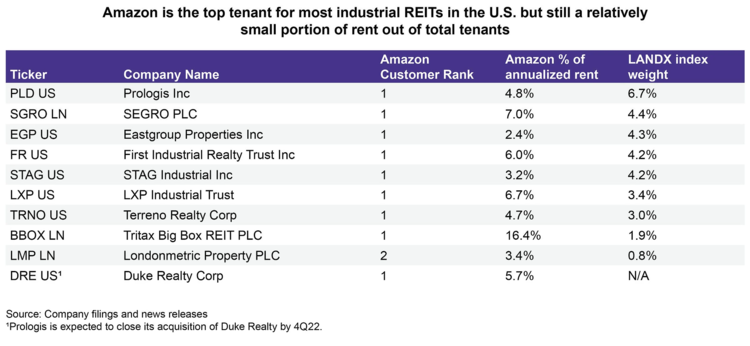[ad_1]
This year Amazon Prime Day occurred on July 12 and 13 and according to Amazon was the “biggest Prime Day event in Amazon’s history,” providing some insight into overall 3Q e-commerce sales strength. Amazon’s name has become almost synonymous with e-commerce, and the “Amazon Effect” has changed the way consumers experience shopping and also the way retailers manage their supply chains. With its size, scale, and cultural influence, the company has been driving shifts even beyond retail—prompting some investors to look for other ways to participate in some of the long-term trends that support and/or result from Amazon’s wide scope of businesses. Besides e-commerce and online shopping, this note also explores thematic shifts toward electric vehicles, e-commerce real estate, and cloud computing.
Amazon has helped drive higher online sales for the overall retail industry.
While Amazon doesn’t release exact sales figures for Prime Day, the company announced that this year’s event was the largest Prime Day event in history with Prime members purchasing 300 million items globally.(1) According to data from Adobe Analytics, Amazon Prime Day saw approximately $11 billion in online sales in 2021 and grew to approximately $12 billion in 2022 (these sales are total online sales across all retailers—not just Amazon). Amazon Prime Day has become equivalent to a major spending holiday and its impact now extends beyond Amazon itself. Prime Day has helped boost sales across both Amazon’s selling partners (most of which are small and medium-sized businesses) and also competing retailers. The percentage of non-Amazon sales during these Prime Day has grown over the years to 40% of total sales as many retailers also host sales on the same day (e.g., Wal-Mart’s Deals for Days sale and Target’s Deal Days sale). Sales growth for Amazon’s selling partners this year also outpaced Amazon’s retail business with customers spending over $3 billion on over 100 million small business items.
The S-Network Global E-Commerce Index (ECOMX) tracks companies that are engaged in the global e-commerce industry, including online retail, online marketplaces, content navigation, and e-commerce infrastructure segments. The index includes companies like Amazon (AMZN, 1.7% index weight), Shopify (SHOP, 1.5% index weight), Wal-Mart (WMT, 1.8% index weight), FedEx (FDX, 1.6% index weight), and United Parcel Service (UPS, 1.7% index weight).(2)

Demand for expedited deliveries spurs the need for cleaner, more efficient delivery vehicles (i.e., electric vehicles).
The surge in e-commerce demand has also increased demand for high volume, expedited deliveries. While shipping models previously consisted of sending products through heavy-duty trucks to retail stores, e-commerce has contributed to the rise of “last mile delivery” which involves shipping directly from distribution center to the consumer, typically through parcel trucks like those from FedEx and UPS. Parcel carriers and large retailers like Amazon and Wal-Mart have been expanding their last mile fleets to keep up with demand, while also investing in cleaner, more efficient, and more technologically advanced electric vehicles. The table below shows several major parcel carriers and retailers who are electrifying their fleets and partnering with electric vehicle manufacturers in order to match demand from e-commerce. There are also several other smaller partnerships not shown in the table—for example, Amazon also has a partnership with Stellantis (STLA IM) to be its first commercial customer in 2023 for an undisclosed number of its Ram ProMaster Battery Electric Vehicle.(3) FedEx also has smaller orders for electric delivery vehicles with Xos Trucks (XOS).(4)
The S-Network Electric & Future Vehicle Ecosystem Index (FUTURE) provide access to stocks that are materially engaged in the development and sales of electric and autonomous vehicle technologies. These include companies mentioned below like Rivian Automotive (RIVN, 0.5% index weight), Stellantis NV (STLA IM, 0.5% index weight), and General Motors (GM, 0.9% index weight).
Content continues below advertisement

Shift toward fulfillment models prioritizes larger real estate space in strategic locations.
As mentioned above, Amazon has shifted retail models to prioritize strategic location of fulfillment centers and more real estate space. E-commerce tenants typically require three times the logistics real estate as a traditional retailer due to wider product levels, greater inventory levels, and larger outbound shipping requirements, according to Prologis (PLD).(5) Amazon is the top tenant in most US and UK industrial REITs; however, it is still a relatively small portion of total annualized rent, illustrating the fragmentation of the market. Even with Amazon pulling back on some of its real estate space as demand normalizes post-pandemic, there is still demand for real estate space among other e-commerce tenants.
The Alerian Disruptive Technology Real Estate Index (LANDX) is an index of stocks that own, operate and/or lease real estate that supports advanced wired and wireless communication, data storage and processing infrastructure, e-commerce warehouses and fulfillment centers. As of July 15, 58.1% of LANDX by index weight was in e-commerce warehousing.

Amazon cloud and web services support the overall shift to digital trends.
While Amazon has become well-known for its effect on retailing and shipping models, it’s easy to overlook over the company’s significant impact on internet technology. While revenues from Amazon Web Services (AWS) make up only 13% of the company’s net revenue (during FY2021), AWS contributes close to 75% of the company’s operating income—far higher than its e-commerce/retail profits. AWS includes cloud computing and other IT infrastructure services. Demand for cloud computing has grown significantly along with penetration of connected devices, remote workforce, and the increasing global scale of businesses. Amazon’s AWS customers range from Netflix (who uses AWS for its databases, analytics, and recommendation engines), Coca-Cola (who uses AWS architecture for its touchless soda fountains), and Expedia (who uses AWS infrastructure to meet high traffic and high availability requirements of its online platform).(6) Amazon AWS is currently the leader in cloud computing with approximately 33% market share in 1Q22 followed by Microsoft Azure (21% market share), and Google Cloud (8%) market share.(7)
The O’Shares Global Internet Giants Index (OGIGX) provides access to companies that derive the majority of their revenues from internet technology and/or internet commerce. These include companies like Amazon (AMZN, 5.0% index weight), Alphabet (GOOGL, 6.3% index weight), and Microsoft Corp (MSFT, 6.2% index weight).

Bottom Line:
Amazon has had both a cultural and economic impact across the globe. While e-commerce is one of the most compelling stories underlying the company, Amazon’s size, scale, and cultural influence has driven several other key megatrends besides online shopping including electric vehicles, e-commerce real estate, and cloud computing.
The S-Network Global E-Commerce Index (ECOMX) is the underlying index for the First Trust S-Network E-Commerce ETF (ISHP).
The S-Network Electric & Future Vehicle Ecosystem Index (FUTURE) is the underlying index for the First Trust S-Network Future Vehicles & Technology ETF (CARZ).
The Alerian Disruptive Technology Real Estate Index is the underlying index for the First Trust Alerian Disruptive Technology Real Estate UCITS ETF (DTRE).
The O’Shares Global Internet Giants Index (OGIGX) is the underlying index for the ALPS O’Shares Global Internet Giants ETF (OGIG). The OGIGX Index is owned by O’Shares ETF Investments.
Related Research:
Thematic Times: Secular Shift to Online Shopping Continues
Investing in E-Commerce: The Future of Search, Shop, & Ship
Legacy Automakers Charge Ahead of New Entrants in EV Push
LANDX Provides Solid Ground for Future of Disruptive Tech
Global Internet Giants Dominate in 2020
(1) “Prime Day 2022 was the Biggest Prime Day Event Ever”:https://press.aboutamazon.com/news-releases/news-release-details/prime-day-2022-was-biggest-prime-day-event-ever
(2) All index weights in this report are as of July 15, 2022
(3) “Amazon and Stellantis Collaborate|Stellantis”:https://www.stellantis.com/en/news/press-releases/2022/january/amazon-stellantis-collaborate-on-software-solutions
(4) “Xos Q12022 Earnings Call Script”:https://investors.xostrucks.com/static-files/12601bcc-1f12-4b1d-978f-73b9e2721f41
(5) “Global E-Commerce Impact on Logistics Real Estate | Prologis”:https://www.prologis.com/news-research/global-insights/global-e-commerce-impact-logistics-real-estate
(6) “Cloud Computing Services – Amazon Web Services”:https://aws.amazon.com/?nc2=h_lg (AWS)
(7) Cloud Market Share 2022
[ad_2]
Source link








